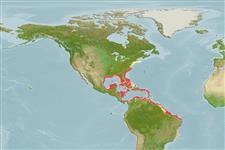Common names from other countries
>
Eupercaria/misc (Various families in series Eupercaria) >
Lutjanidae (Snappers) > Lutjaninae
Etymology: Lutjanus: Malay, ikan lutjan, name of a fish.
More on author: Walbaum.
Environment: milieu / climate zone / depth range / distribution range
Ecologie
marien; brak water rifbewoner; diepte 2 - 63 m (Ref. 9626). Subtropical; 42°N - 19°S, 98°W - 31°W (Ref. 55)
Western Atlantic: north to Massachusetts, USA (rare in Florida) and south to Trinidad and northern Brazil.
Lengte bij maturiteit / Grootte / Gewicht / Leeftijd
Maturity: Lm 25.0 range ? - ? cm
Max length : 79.1 cm FL mannelijk / geslacht onbekend; (Ref. 69373); common length : 35.0 cm TL mannelijk / geslacht onbekend; (Ref. 55); max. gepubliceerd gewicht: 10.8 kg (Ref. 26340); max. gerapporteerde leeftijd: 42 Jaren (Ref. 128039)
Dorsale stekels (totaal) : 10; Dorsale zachte stralen (totaal) : 14; Anale stekels: 3; Anale zachte stralen: 8. Snout long and pointed, mouth large. One of the upper pairs of canine teeth notably enlarged, visible when mouth is close. Preopercular notch and knob weak. Pectoral fins long, reaching the level of anus. Scale rows on back parallel to lateral line, at least anteriorly. Olive gray to brownish on upper back and sides, with eight narrow, pale vertical bars which may be faint or absent in large adults. A solid or broken blue line which may disappear with growth, runs under the eye.
Adults occur in shallow, clear, warm, coastal waters over coral reefs. Often near the shelter of elkhorn corals and gorgonians (Ref. 9710). Juveniles are encountered over sand bottoms with or without seagrass (Thalassia), and over muddy bottoms of lagoons or mangrove areas. Young sometimes enter brackish waters. Sometimes form resting aggregations during the day. Feed on fishes, shrimps, crabs, worms, gastropods and cephalopods. Considered a good food fish, it is marketed fresh or frozen (Ref. 55). Maximum length for female taken from Ref. 3093.
Allen, G.R., 1985. FAO Species Catalogue. Vol. 6. Snappers of the world. An annotated and illustrated catalogue of lutjanid species known to date. FAO Fish. Synop. 125(6):208 p. Rome: FAO. (Ref. 55)
Status op de Rode Lijst van het IUCN (Ref. 130435)
CITES (Ref. 128078)
Not Evaluated
Gevaar voor de mens
Reports of ciguatera poisoning (Ref. 30911)
Gebruik door de mens
Visserij: commercieel
Tools
Speciale rapporten
Download XML
Internetbronnen
Estimates based on models
Preferred temperature (Ref.
115969): 23.3 - 28, mean 26.4 (based on 412 cells).
Fylogenetische diversiteitsindex (Ref.
82804): PD
50 = 0.5000 [Uniqueness, from 0.5 = low to 2.0 = high].
Bayesian length-weight: a=0.01479 (0.01312 - 0.01668), b=2.97 (2.95 - 2.99), in cm Total Length, based on LWR estimates for this species (Ref.
93245).
Trofisch niveau (Ref.
69278): 4.3 ±0.4 se; based on diet studies.
Weerstandsvermogen (Ref.
120179): laag, minimale populatieverdubbelingstijd 4,5-14 jaar (Preliminary K or Fecundity.).
Prior r = 0.60, 95% CL = 0.39 - 0.89, Based on 1 data-limited stock assessment.
Fishing Vulnerability (Ref.
59153): High vulnerability (62 of 100).
